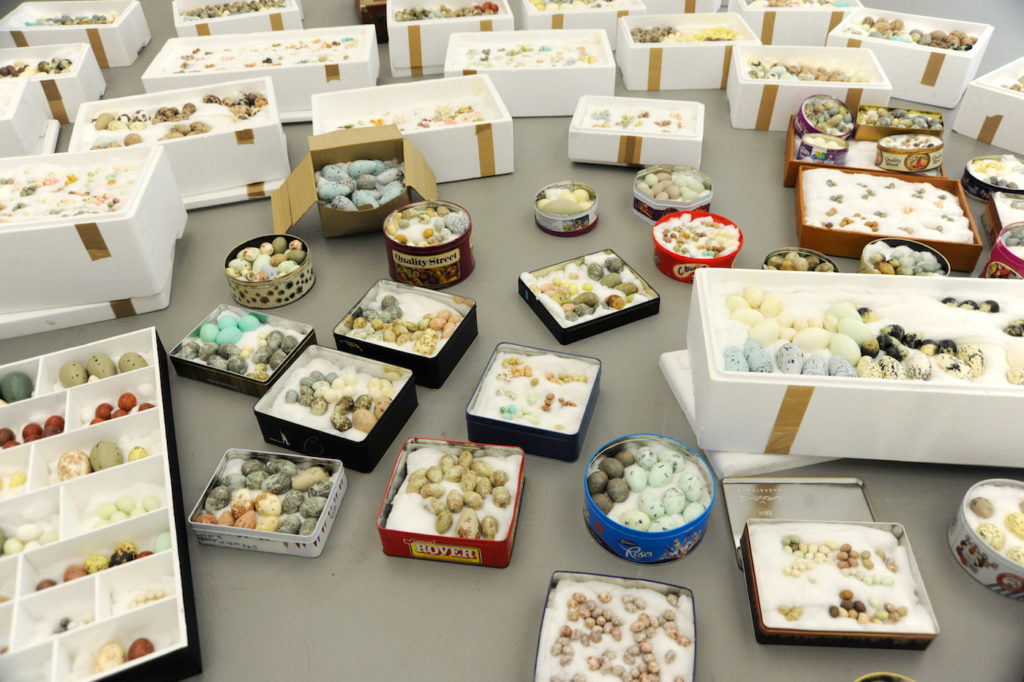Esther Fox
“The desire to possess something rare can sometimes have terrible consequences for the thing collected”
This sentence from the literature for the Natural Selection exhibition at Towner Gallery, Eastbourne, rang out to me. But in the context of genetic screening it was I, a rare oddity, which was on the cusp of extinction. However my threatened existence is not perhaps because I am seen to be so rare as to be valuable and worthy of collection and preservation; but for the opposite reason; my unusualness troubles notions of normality and conformity and therefore should not be preserved, but instead extinguished and discarded.
Natural Selection looked at two unlikely themes for a contemporary art exhibition: nest building and egg collection. This exhibition represented a collaboration between father and son, a well-known bird expert Peter Holden and artist Andy Holden. I described my thoughts on the connection between nest building and genetics in part one, but in this blog I want to explore the nature of collecting.

Andy Holden & Peter Holden – Natural Selection. Towner Art Gallery, Eastbourne, 2018. Photo © Alison Bettles
There is an inherent human desire to collect and arrange. Last year as part of the D4D project, Sue Moffat and I facilitated an activity called “the button exercise”. This capitalises on the very human desire to arrange, contain, collect and present. In this exercise, two groups of participants were asked to follow one instruction “arrange the buttons”. They were confronted with a variety of buttons and some items that didn’t fit that category and they quickly set about the task of sorting and arranging. Only one participant voiced a concern saying “I could say but why are we doing this… but I will go along with the group”.
The groups were then asked to explain why they had made their choices; some were based on colour, some on value and others because they didn’t neatly fit in. What this exercise demonstrated was just how quickly and unquestioningly the majority of people relish the task of creating order out of what appears to be chaos. Perhaps there is no better example than the Victorian era to exemplify this passion.
Francis Galton the ‘father’ of eugenics and half cousin of Charles Darwin, began to propose ways not only to categorise the natural world, but that of humanity. He was the first to apply statistical methods to the study of human differences particularly exploring inheritance and intelligence.
As I entered the second gallery space in the exhibition, there were clear references to this Victorian obsession to collect, arrange, categorise and label. A series of feathers displayed in a glass case and presented through a structured system of classification, echoed the Victorian tradition of preserving specimens taken from the natural world. Part of the appeal of the collector appears to be to create order and conformity and to demonstrate that man is more powerful than nature and can tame its messiness.
If we accept this is an inherent human desire then should we not question the motives for extending this control in the development of more widespread genetic screening, rather than racing towards a Victorian simplified judgement system, where value is placed on productivity and homogenisation?

Andy Holden & Peter Holden – Natural Selection. Towner Art Gallery, Eastbourne, 2018. Photo © Alison Bettles
Entering the final space a vast collection of eggs was strewn out on the floor, presented in a mix and match of biscuit tins, polystyrene cases and cardboard boxes, a complete contrast to the beautifully presented and sterilised specimens that the Victorians were so proud of. This was a recreation of a hoard of 7,130 eggs discovered by the RSPB. The act of collecting was now illegal, private and illicit, not for public admiration. This hoard was destroyed because if it had been passed to a Museum the act of collecting would then have been endorsed. The eggs in the exhibition were beautifully crafted porcelain copies, but despite knowing that, I still felt a sense of sadness, looking at the latent potential of life which was not to be.
On the wall behind the vast hoard was a chart of the egg collectors, reminiscent of a family tree and similar to the hereditary charts that the eugenics society was so fond of. This time the collectors became the object of study, the gaze was reversed.
We were invited to scrutinize and measure them. Was their obsession to collect moral or justified and at what cost? What started as an act of the aristocratic scientist had become a danger to the very thing those early collectors sought to record and preserve.
The parallels were clear to me, our rapid move towards genetic screening endorses our contemporary scientific desire to categorise, label and only allow perfect specimens to survive. But will the gaze be reversed in the future and in this instance will society question whether it really was moral or humane to allow whole communities of disabled people to become nothing more than an extinct species?
